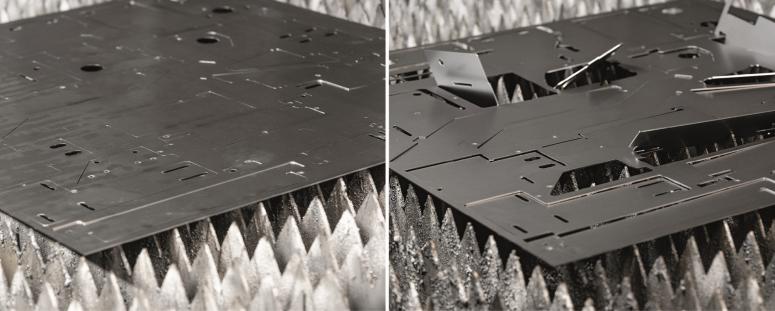* Photo: Left: Perfect cutting result thanks to “TiltPrevention”. Right: Tilted parts after laser cutting without “TiltPrevention”.
With the “TiltPrevention” assistant function, Bystronic is increasing process reliability in the field of laser cutting. The intelligent function enables users to create cutting sequences that minimize the risk of creating protruding parts in the sheet. This reduces the disruption of cutting processes and downtime caused by cutting head collisions.Tilted parts are a risk factor during the laser cutting process. They can cause a collision with the cutting head.
This results in the disruption of cutting jobs, rejected parts, and in the worst case, costly damage. However, they also impede automated unloading, as the automation system’s grippers have difficulty picking up tilted parts.
Until now, micro-tabs have been a time-intensive method of preventing cut-out parts from tilting. The software positions small connections between the contour of the part that is to be cut and the residual grid in the cutting plan. In this way, parts remain fixed to the surrounding sheet after cutting. One disadvantage of this solution is: The cut parts require reworking in order to remove the traces of the micro-tabs. Another disadvantage: The automated removal of the finished parts is impeded because the micro-tabs make it difficult to remove the parts from the residual sheet.
Another approach is to use software to guide the paths of the cutting head during the cutting process so that, as far as possible, it circumvents risky sections where parts could tilt. However, this solution does not eliminate the root of the problem: Parts protrude, still represent a risk, and are difficult for automation systems to cope with.
Algorithm generates the ideal cutting sequence
With “TiltPrevention” Bystronic has now developed a new solution. In future, BySoft 7 will use this intelligent assistant function to compile cutting plans in such a manner that parts cannot tilt during the cutting process. This largely eliminates the need for micro-tabs.
How does it work? An algorithm calculates the mechanical behavior of the parts while they are being cut out of the sheet. To achieve this, “TiltPrevention” takes into account a wide range of parameters: What is the density of the material that is being cut? What is the geometry and weight of the parts that are to be cut? How high is the pressure of the gas that flows out of the cutting head during laser cutting and exerts pressure on the parts? How are the parts positioned on the cutting grate? Are there enough contact points?
Subsequently, “TiltPrevention” recommends lead-in and lead-out points of the laser so that tilting of the parts after cutting is prevented to the greatest possible extent. In addition, the function proposes the best possible route for the cutting head over the metal sheet. This creates an ideal cutting sequence for all parts on the cutting plan. Cutting in such a manner that the cutting head never travels over parts that have already been cut out.
Regardless of the users’ level of experience, “TiltPrevention” supports them with an ideal cutting strategy that can be automatically incorporated into the cutting plan. Users can carry out customized adaptations at any time using the simulation created by “TiltPrevention”: modify the nesting of parts, reposition the lead-in and lead-out points of the parts, and add micro-tabs where required.
2D Laser cutting machines BYSTRONIC
Metal-Interface takes great care to protect your privacy: when you submit a request or ask a question, your personal information is passed on to the supplier concerned or, if necessary, to one of its regional managers or distributors, who will be able to provide you with a direct response. Consult our Privacy Policy to find out more about how and why we process your data, and your rights in relation to this information. By continuing to browse our site, you accept our terms and conditions of use.
 2D Laser cutting Press release
2D Laser cutting Press releaseProcess reliability in the field of laser cutting
